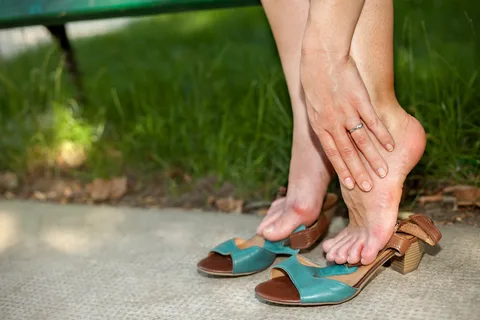Finding a comfortable pair of shoes can be difficult if you suffer from swollen feet. Not only do swollen feet cause immense discomfort, but it can also be hard to find shoes that fit properly and provide adequate support. Fortunately, several types of shoes are designed specifically for people with swollen feet that can help relieve pain and provide comfort. This blog post will discuss some of the best <a href=”https://www.medicomfshoes.com/best-adjustable-shoes-for-swollen-feet/”><strong>shoes for swollen feet</strong></a> and how they can help you manage your discomfort.
Understanding Swollen-Feet
Swollen feet, medically known as edema, refer to the abnormal accumulation of fluid in the tissues of the feet and ankles. This condition can result from various factors, including prolonged periods of standing, hot weather, injury, pregnancy, certain medications, and underlying medical conditions like heart disease, kidney problems, or venous insufficiency.
Swollen feet often manifest as puffiness, tightness, and discomfort, making walking difficult and wearing regular shoes. Elevating the feet, wearing compression stockings, and reducing sodium intake can help alleviate mild edema. However, persistent or severe swelling may require a medical evaluation to identify and address the underlying cause effectively.
Causes of Swollen-Feet
Swollen feet can have various causes, and understanding these causes can help you manage and prevent the discomfort. One common cause of swollen feet is pregnancy. During pregnancy, hormonal changes can lead to fluid retention, causing swelling in the feet and ankles. Another cause of swollen feet is prolonged periods of standing or sitting.
When you stay in one position for too long, blood can pool in the lower extremities, leading to swelling. Certain medications, such as antidepressants or blood pressure medications, can also cause fluid retention and swelling in the feet. Injuries, such as sprains or fractures, can also result in swollen feet. Finally, heart disease or kidney problems can cause fluid buildup and swelling.
Tips To Manage Swollen-Feet
When it comes to managing swollen feet, a few tips can make a big difference. First and foremost, it’s important to elevate your feet whenever possible. Raising your feet above heart level can help reduce fluid buildup and alleviate swelling. Additionally, avoiding tight socks or stockings and opting for loose, breathable footwear can help improve circulation and prevent further discomfort. Regular exercise like walking or swimming can promote blood flow and reduce swelling.
 If your swollen feet result from an underlying medical condition, working closely with your healthcare provider to manage and treat the condition effectively is important. Lastly, maintaining a healthy diet low in sodium and high in potassium can help regulate fluid balance in the body. By incorporating these tips into your daily routine, you can effectively manage and alleviate the discomfort of swollen feet.
If your swollen feet result from an underlying medical condition, working closely with your healthcare provider to manage and treat the condition effectively is important. Lastly, maintaining a healthy diet low in sodium and high in potassium can help regulate fluid balance in the body. By incorporating these tips into your daily routine, you can effectively manage and alleviate the discomfort of swollen feet.
Features To Look For In Shoes for Swollen-Feet
When it comes to finding the perfect pair of shoes for swollen-feet, several key features can make all the difference in your comfort and relief. First and foremost, opt for shoes with a wide and roomy toe box. This will provide ample space for your swollen feet without causing any additional pressure or discomfort. Adjustable straps or laces are another important feature, as they allow you to customize the shoe’s fit to accommodate the swelling.
Look for shoes with a supportive and cushioned insole to provide extra comfort and reduce the impact on your feet. Choosing shoes made from breathable materials that allow for airflow and prevent excessive sweating is also beneficial. Lastly, consider shoes with a flexible sole that allow your feet to move naturally and provide added stability. By keeping these features in mind when shopping for shoes, you can find a pair to help alleviate your pain and provide the comfort you deserve.
Importance of Shoes for Swollen-Feet
The importance of wearing the right shoes cannot be overstated when managing swollen feet. Choosing shoes specifically designed for swollen feet can make a difference in comfort and pain relief. These shoes are designed with features that accommodate the unique needs of swollen feet, such as a wide toe box, adjustable straps or laces, and cushioned insoles.
Providing ample space, support, and cushioning, these shoes help reduce pressure and discomfort, allowing your swollen feet to breathe and heal. They also promote better circulation and prevent further swelling. Wearing the right shoes can significantly impact your daily life, allowing you to go about your activities with less pain and discomfort.
How to Properly Fit Your Shoes for Swollen-Feet
When finding the perfect pair of shoes for swollen-feet, it’s essential to ensure they fit properly. Ill-fitting shoes can worsen the discomfort and pain associated with swollen feet. To properly fit your shoes, start by measuring your feet regularly, as swelling can cause changes in size.
When trying on shoes, do it later in the day when your feet are likely at their largest. Look for shoes with adjustable straps or laces, allowing you to customize the fit to accommodate swelling. Pay attention to the width and depth of the toe box, as it should provide ample space for your swollen feet without causing any additional pressure.
Ensure that the shoe doesn’t squeeze or rub against any swollen areas. Walk around in the shoes to see if they provide the right support and cushioning. It’s also important to try on both shoes and ensure they feel comfortable and stable. By following these fitting tips, you can find shoes that will provide comfort and support for your swollen feet.
Common Mistakes to Avoid When Choosing Shoes for Swollen Feet
When it comes to choosing shoes for swollen feet, there are some common mistakes that you should avoid to ensure maximum comfort and relief. One common mistake is selecting shoes that are too tight or narrow. This can further compress the feet and cause discomfort. Instead, opt for shoes with a wide, roomy toe box that allows your swollen feet to breathe and move comfortably.
Another area for improvement is overlooking the importance of adjustable straps or laces. These features are essential for accommodating swelling and ensuring a proper fit. Additionally, avoid shoes with flat or unsupportive soles, as they can exacerbate the pain and discomfort of swollen feet.
Instead, choose shoes with a flexible and cushioned sole that provides stability and absorbs shock. Lastly, remember to consider the materials of the shoes. Breathable materials can prevent excessive sweating and keep your feet cool and comfortable. By avoiding these common mistakes, you can find shoes that alleviate your pain and provide the comfort you deserve.
Other Tips for Dealing with Swollen-Feet
Managing swollen feet goes beyond just finding the right shoes. A few other tips can help alleviate discomfort and promote healing. One important tip is to practice regular foot exercises and stretches. Simple movements like flexing your toes, rotating your ankles, and doing calf stretches can help improve circulation and reduce swelling. Additionally, try soaking your feet in warm water with Epsom salts or using cold compresses to alleviate pain and inflammation.
It’s also important to avoid crossing your legs when sitting, as this can impede blood flow and worsen swelling. Lastly, if your swollen feet are causing severe pain or if you notice any unusual symptoms, it’s important to seek medical advice. Remember, these additional tips can complement the use of appropriate shoes and help you better manage the discomfort of swollen feet.
FAQ’s
1. Are there specific shoe brands specialising in swollen feet shoes?
Yes, several shoe brands offer a wide range of options for swollen feet.
2. Can I wear regular shoes for swollen feet?
While it’s not recommended, you can wear regular shoes for swollen feet if they provide enough room and support. However, opting for shoes specifically designed for swollen feet is best to ensure maximum comfort and relief.
3. Can compression socks help with swollen feet?
Yes, compression socks can be beneficial for managing swelling in the feet. They apply gentle pressure to the legs, which helps improve circulation and reduce fluid buildup.
4. Are there any natural remedies for swollen feet?
Yes, several natural remedies can help alleviate swelling in the feet. Elevating your feet, soaking them in Epsom salt water, and applying cold compresses are all effective methods.
5. Can exercise worsen swelling in the feet?
In general, exercise can help improve circulation and reduce swelling in the feet. However, choosing low-impact exercises and listening to your body is important. If you experience increased pain or discomfort, it’s best to consult with a healthcare professional.
6. Can I wear sandals if I have swollen feet?
Yes, you can wear sandals if they have adjustable straps and provide enough support and cushioning for your swollen feet. Look for sandals with a wide toe box and arch support.
Conclusion
In summary, finding the right pair of shoes for swollen-feet is crucial for managing discomfort and finding relief. You can take control of your discomfort by understanding the causes of swollen feet and implementing tips to manage the condition, such as elevating your feet and maintaining a healthy diet. When choosing shoes, look for features like a wide toe box, adjustable straps, and cushioned insoles to provide comfort and support. Avoid common mistakes and consider additional tips like foot exercises and natural remedies to complement proper shoes. Remember, with the right shoes and lifestyle adjustments, you can alleviate the pain and discomfort of swollen feet and go about your daily activities with ease.



